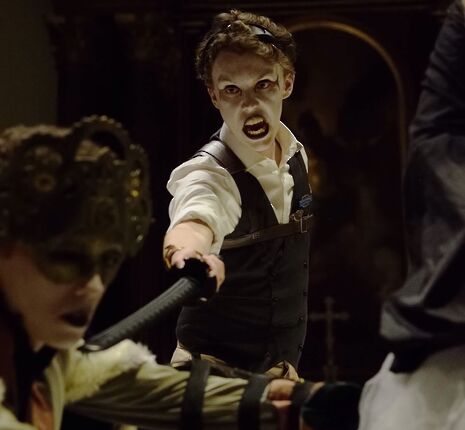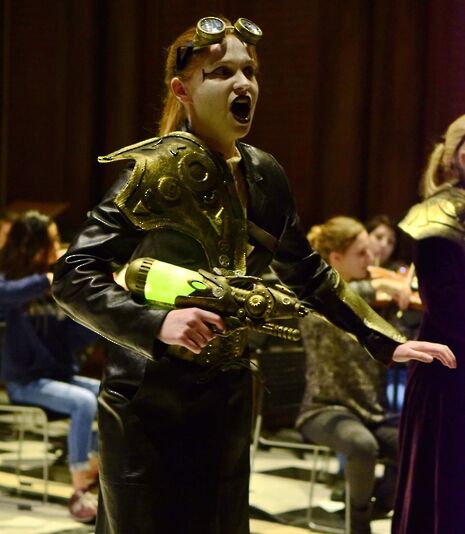Review: Radamisto
Joseph Connor finds moments of CUOS’s latest opera “effortlessly beautiful.”

Handel’s Radamisto is almost Shakespearean in its complex web of characters, romances, and deceptions which explore the extremities of human emotion in extraordinary circumstances.
The drama begins as the King of Armenia, Tiridate (Frankie Postles), is besieging the Thracian capital so that he might claim Zenobia (Anna-Luise Wagner) as his wife. Alas, he is already married to Polissena (Maia Béar), and Zenobia to Radamisto (Jack Hawkins). In his opening aria, Postles managed to magisterially capture the belligerent masculinity of the prospective adulterer with a tone which was never coarse.
“The coloratura runs and high notes were very well executed indeed”
In exchange for her father, Farasmane (James Quilligan), whom Tiridate has captured, Zenobia offers her hand to Tiridate. However, it is Farasmane’s unconditional love for his daughter, a trait conveyed wholly convincingly by the warmth of Quilligan’s sonorous bass tone, that prevents this from happening. The title character and his wife, Zenobia, manage to flee Tiridate’s tyranny (if only for a scene or two) and discuss whether the solution would be for Zenobia to die married to Radamisto rather than fall into the hands of Tiridate. When Radamisto is unable to kill his wife, she takes matters into her own hands and throws herself into a river. Hawkins’ ensuing aria had the audience captivated as his warmth of tone and dynamic expression left us all grieving alongside Radamisto.
Act III opened with an impressive duet between Tigrane (Katie Kirschbaum) and Fraarte (Tiffany Charnley) in which the coloratura runs and high notes were very well executed indeed. Wagner’s portrayal of Zenobia alongside Hawkins’ Radamisto in their final duet was effortlessly beautiful and the masterful lamenting music that Handel wrote was offered up in a remarkably humble manner that moved all those watching.

The Chapel at Trinity College provides a challenging environment to stage opera, but Thomas Stell did a fine job in working ergonomic miracles with no staging. A screen comprised a backstage and the orchestra played from the side, but it was the simplicity of gesture and movement juxtaposed with the outstanding, faintly surrealistic costumes by Gwen Davis which draw on elements of a fantastically bizarre melange of steampunk, science fiction and the eighteenth-century, that made most of the chapel. Often characters were alone on stage, left behind to express either despair or resolve – the opening aria, in which Polissena, arms raised to the heavens, asks the gods to shield her from her emotional agony was particularly captivating and skilfully sung.
“Luke Fitzgerald conducted with an exceptional degree of clarity”
It must be said that the orchestra was particularly good. Luke Fitzgerald conducted with an exceptional degree of clarity that didn’t impose on the natural musicianship of the players. He showed everything needed for the performance to be a great success and nothing more; a balance that, in this sort of music, is vital to let it come alive. Kavi Pau, as assistant musical director, played the harpsichord very tastefully and Laura Alexander, who had the challenge of leading the orchestra, did so with panache. Occasionally the orchestra overpowered some voices, especially in solo arias; the decision to use English rather than the original Italian was well received, but diction was occasionally lacking in the challenging acoustic.
I thoroughly enjoyed this CUOS production and hope to see those involved in other productions soon
 Comment / Plastic pubs: the problem with Cambridge alehouses 5 January 2026
Comment / Plastic pubs: the problem with Cambridge alehouses 5 January 2026 News / Cambridge academics stand out in King’s 2026 Honours List2 January 2026
News / Cambridge academics stand out in King’s 2026 Honours List2 January 2026 News / Cambridge businesses concerned infrastructure delays will hurt growth5 January 2026
News / Cambridge businesses concerned infrastructure delays will hurt growth5 January 2026 News / AstraZeneca sues for £32 million over faulty construction at Cambridge Campus31 December 2025
News / AstraZeneca sues for £32 million over faulty construction at Cambridge Campus31 December 2025 Interviews / You don’t need to peak at Cambridge, says Robin Harding31 December 2025
Interviews / You don’t need to peak at Cambridge, says Robin Harding31 December 2025








